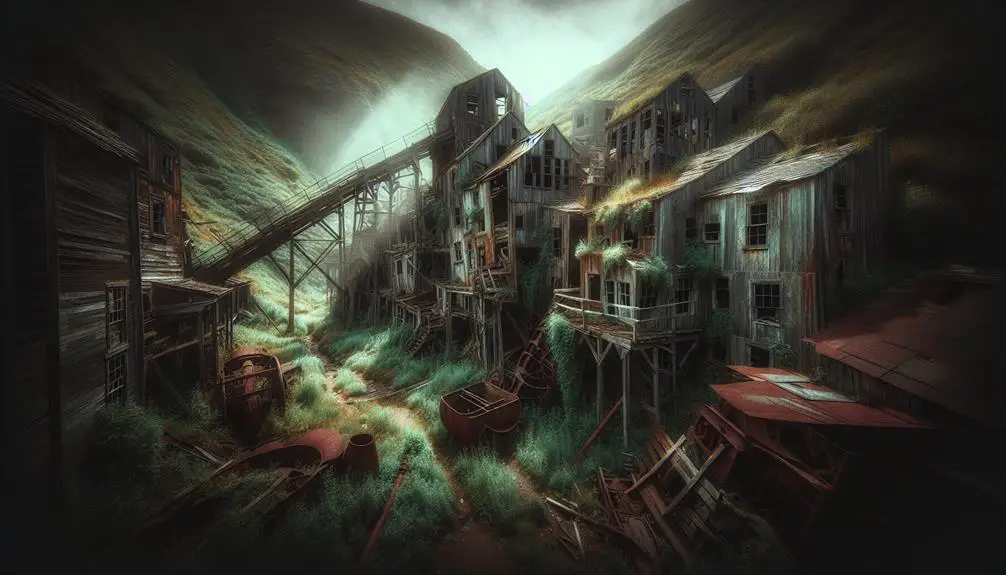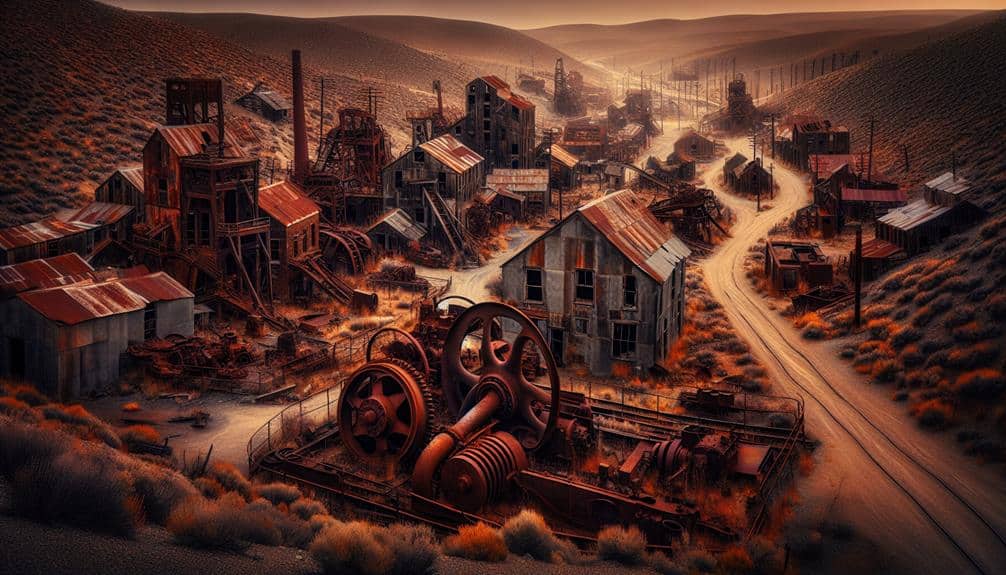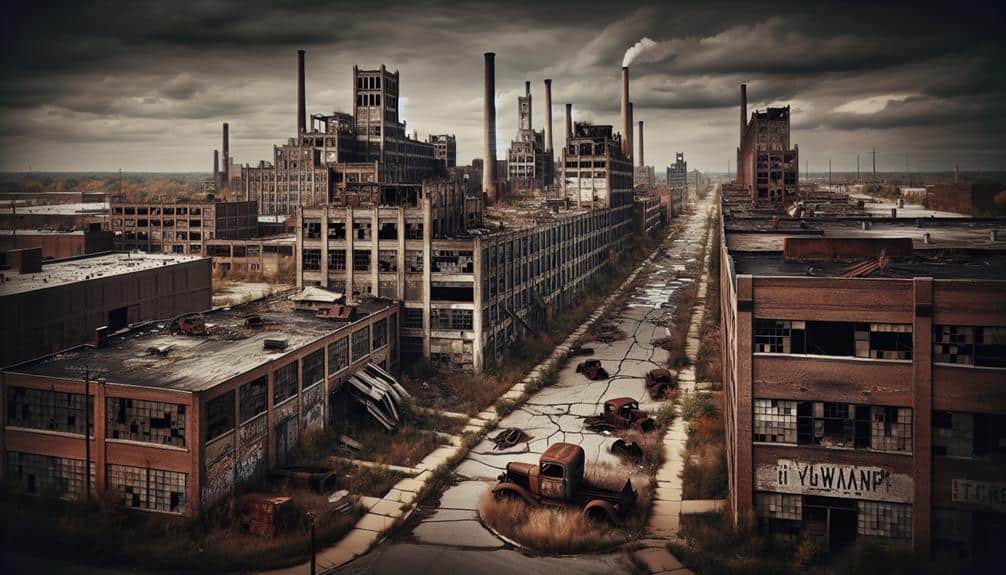Explore Goldfield, Nevada with its historic gold discovery and ongoing restoration. Visit Kennecott, Alaska for its copper mines and remote allure. Bodie, California offers a glimpse into the late 1800s gold rush era. Centralia, Pennsylvania's coal mine fire tragedy still lingers. Investigate Ruby, Arizona's declining mining impact. Witness environmental concerns at Gilman, Colorado. Admire Rhyolite, Nevada's diverse architecture. Comet, Montana reflects on the transient nature of settlement. Swansea, Utah tells a story of boom and bust in mining towns. Finally, Ludlow, Colorado preserves a turbulent history. Each village holds a tale waiting to be discovered.
Key Points
- Goldfield, Nevada: Historic mining town with ongoing restoration efforts and tourist attractions.
- Kennecott, Alaska: Remote copper mining town with preservation efforts symbolizing resilience.
- Bodie, California: Frozen in time gold mining town with ghost town tourism appeal.
- Centralia, Pennsylvania: Haunting coal mine fire disaster causing irreparable damage and displacement.
- Ruby, Arizona: Former mining town with preserved remnants and cultural significance.
Goldfield, Nevada
Located in the state of Nevada, Goldfield stands as a stark reminder of the once-thriving mining industry that defined its history. The town's mining history dates back to the early 1900s when gold was discovered in the area, leading to a boom in population and economic prosperity. However, as the gold reserves dwindled, the town experienced a rapid decline, leaving behind a landscape dotted with abandoned structures that now attract tourists interested in exploring the remnants of the past.
Today, Goldfield's abandoned structures serve as a proof to the resilience of the town and its people in the face of economic challenges. Efforts towards restoration have been ongoing, with some of the historic buildings being preserved to maintain the town's unique character and attract visitors looking to investigate into its mining past. The tourism industry in Goldfield has seen growth as more people seek to learn about the town's mining heritage and witness firsthand the impact of the industry on the local community.
Kennecott, Alaska
Kennecott, Alaska, holds immense historical significance as a once-thriving mining town in the early 20th century, known for its copper deposits and the iconic Kennecott Mines.
Preservation efforts in Kennecott have been ongoing, aiming to maintain the integrity of the town's structures and tell the story of its mining past to future generations.
The remote location of Kennecott adds to its allure, attracting visitors interested in exploring a well-preserved piece of America's industrial history.
Historical Significance of Kennecott
Nestled in the remote Alaskan wilderness, Kennecott stands as a demonstration of the resilience and ingenuity of early 20th-century mining communities. The historical significance of Kennecott lies in its connection to the Industrial Revolution, showcasing innovative architecture that integrated modern amenities into the rugged landscape.
This mining town thrived on copper mining, fueling the nation's growing demand for the precious metal. However, this prosperity came at a cost, with significant environmental impacts resulting from the extraction and processing of copper ore.
Despite these challenges, Kennecott's legacy endures as a symbol of human determination and adaptability in the face of harsh conditions, offering a glimpse into a bygone era of American history.
- Industrial Revolution and innovative architecture
- Copper mining as a crucial economic activity
- Environmental impacts of mining operations
Preservation Efforts in Kennecott
Preservation efforts in Kennecott, Alaska, focus on maintaining and restoring the historic structures that symbolize the town's industrial past and cultural heritage. Mining techniques play a vital role in understanding the development of this region, making conservation efforts essential.
The industrial heritage of Kennecott is preserved through sustainable practices that guarantee the longevity of the town's historical significance. By implementing innovative conservation methods, such as stabilizing structures and protecting artifacts, the town can continue to tell the story of its mining roots.
Sustainability is at the core of these preservation endeavors, aiming to balance the need for historical accuracy with modern-day environmental consciousness. Through these efforts, Kennecott stands as a tribute to the perseverance and ingenuity of its mining community.
Bodie, California
Situated in eastern California, Bodie stands as a stark reminder of a once-thriving gold mining town now frozen in time. The town's history dates back to the late 1800s when gold was discovered, leading to a rapid influx of miners and their families. Today, Bodie's well-preserved buildings offer a glimpse into the past, showcasing the hardships and successes of the mining era.
- Mining History: Bodie's origins lie in the California Gold Rush, with mines dotting the landscape and providing the economic backbone of the town.
- Architectural Preservation: The buildings in Bodie have been left largely untouched, allowing visitors to see a genuine representation of a mining town from the late 19th century.
- Ghost Town Tourism: Despite its remote location, Bodie attracts tourists from far and wide, drawn by the eerie yet mesmerizing atmosphere of a town abandoned in time.
The economic impact of Bodie's ghost town tourism has breathed new life into the area, showcasing the delicate balance between preservation and progress.
Centralia, Pennsylvania
Centralia, Pennsylvania remains a haunting example of the long-lasting effects of underground coal mine fires. In 1962, a fire ignited in the coal mines beneath the town and has been burning ever since, causing irreparable damage to the community. The environmental impact of the fire has been devastating, with toxic gases seeping out of fissures in the ground and polluting the air. Efforts to extinguish the fire have been unsuccessful, leading to ongoing concerns about the health and safety of those living nearby.
The community displacement in Centralia has been drastic, with most residents being forced to leave their homes due to the dangers posed by the underground fire. Buildings have been demolished, and the town that once thrived is now a ghostly reminder of the destructive power of coal mine fires. Despite attempts to contain the fire and mitigate its effects, Centralia serves as a stark warning of the long-term consequences of environmental negligence.
Ruby, Arizona
Ruby, Arizona holds significant historical value as a former mining town that saw prosperity during the late 19th and early 20th centuries.
The abandonment of Ruby was primarily due to the decline in mining activity and the closure of the mines in the area.
Efforts to preserve the remnants of Ruby showcase the ongoing endeavor to conserve its history and heritage for future generations.
Rubys Historical Significance
With a storied past that intertwines with the mining boom of the late 19th century, Ruby, Arizona holds a significant place in the historical landscape of abandoned mining villages in the USA. The cultural impact of Ruby resonates through time, offering glimpses into the lives of miners and their families. The architectural remnants scattered throughout the village tell tales of a bygone era, showcasing the once-thriving community's structures and layout.
Visitors can explore the remnants of houses, stores, and a school, providing a tangible link to the past. Ruby's historical significance is further enhanced by the artifacts and personal belongings left behind, painting a vivid picture of the village's former glory.
- Ruby's cultural impact
- Ruby's architectural remnants
- Exploration of the village's structures
Abandonment Causes in Ruby
The decline of Ruby, Arizona as a thriving mining village can be attributed to a combination of economic shifts, resource depletion, and environmental challenges. Economic decline played a significant role in the abandonment of Ruby, with fluctuating metal prices making mining operations less profitable. As the easily accessible ore was exhausted, the cost of extraction increased, further impacting the village's economy.
Additionally, the environmental impact of mining activities, such as pollution and habitat destruction, led to stricter regulations and higher operating costs. These factors, coupled with the rise of more cost-effective mining locations, ultimately contributed to the abandonment of Ruby as residents sought better opportunities elsewhere.
Preservation Efforts in Ruby
Implementing comprehensive preservation initiatives is essential to safeguarding the historical integrity of Ruby, Arizona, ensuring its significance endures for future generations.
In Ruby, community engagement plays a pivotal role in restoration projects, allowing locals to actively participate in preserving their heritage.
Additionally, focusing on cultural heritage not only revitalizes the town but also creates sustainable tourism opportunities, attracting visitors interested in the history of the region.
Gilman, Colorado
Nestled in the Rocky Mountains, Gilman, Colorado, stands as a haunting reminder of a once-thriving mining community now abandoned. The town's history dates back to the early 1880s when it was established to support the nearby mines extracting valuable minerals like lead, silver, and zinc. Over the years, Gilman flourished with a bustling population and thriving economy driven by the mining industry.
However, as the mines depleted and environmental concerns arose, Gilman's fate took a turn. The town faced challenges related to pollution and health hazards, leading to its eventual abandonment in the 1980s. Today, the remnants of Gilman include eerie abandoned buildings that serve as silent witnesses to its past glory and subsequent decline.
Exploring Gilman offers a glimpse into a bygone era of mining history in Colorado. The decaying structures and deserted streets evoke a sense of melancholy, yet they also bear witness to the resilience and adaptability of communities in the face of changing circumstances. Visit Gilman to witness firsthand the poignant legacy of a once-thriving mining town now frozen in time.
Rhyolite, Nevada
With its intriguing blend of history and desolation, Rhyolite, Nevada, beckons visitors to explore its abandoned remnants. The town's architecture reflects a mix of influences, from traditional wooden structures to innovative designs like the three-story John S. Cook and Brother Bank building, which showcased the town's brief wealth during its mining boom. Rhyolite's unique blend of architectural styles offers a glimpse into the past, sparking curiosity about the lives of its former inhabitants.
- Architectural Diversity: Rhyolite's buildings showcase a diverse range of architectural styles, providing insight into the town's historical development.
- Preservation Efforts: Efforts to preserve Rhyolite's remaining structures highlight the town's significance and potential for historical tourism.
- Photography Opportunities: The striking contrast between the abandoned buildings and the surrounding desert landscape offers fascinating photography opportunities for visitors seeking to capture Rhyolite's essence.
As you wander through the remnants of Rhyolite, you can't help but feel a sense of freedom, imagining the bustling town that once stood in the midst of Nevada's desert.
Comet, Montana
Exploring the desolate remnants of Comet, Montana reveals a haunting tale of a once-thriving mining community left abandoned in the vast expanse of the American West. Comet's environmental impact is evident in the scarred landscapes, where mining activities have left lasting marks on the earth. The community life that once buzzed with activity now lingers only in the whispers of the wind, painting a poignant picture of the transient nature of human settlements.
Amidst the ruins lie Comet's architectural remnants, a mix of dilapidated homes and rusting machinery, offering a glimpse into the past prosperity that once graced these lands. The town's structures stand as silent witnesses to the passage of time, inviting contemplation on the transient nature of human endeavors.
Despite its desolation, Comet holds untapped tourism potential for those intrigued by the allure of abandoned places. The eerie beauty of the ghost town coupled with its historical significance make it a compelling destination for adventurous souls seeking to uncover the mysteries of the American West.
Swansea, Utah
Amidst the rugged terrain of Utah lies Swansea, a forgotten mining town that stands frozen in time. Swansea's history is a tale of booming mining operations that once brought prosperity to its residents but left behind a stark environmental impact. The remnants of the town whisper stories of economic decline and community displacement, painting a poignant picture of a once-thriving settlement now haunted by the ghosts of its past.
Swansea, Utah was once a bustling hub of mining activities, extracting valuable resources from the earth and fueling the local economy. However, the mining operations took a toll on the surrounding environment, leaving scars that still linger today. As the demand for resources waned and the mines dried up, Swansea faced rapid economic decline, forcing its inhabitants to seek livelihoods elsewhere and leading to the eventual displacement of the community.
Swansea now stands as a reflection of the rise and fall of mining towns, a silent witness to the cyclical nature of boom and bust industries.
Ludlow, Colorado
Swansea's echoes of prosperity and decline find resonance in Ludlow, Colorado, a once-thriving mining community now abandoned and weathered by time. Ludlow was once a bustling hub for mining laborers seeking their fortunes in the coal mines. However, the harsh realities of mining life brought immense hardships to the residents, with poor working conditions and low wages prevalent.
One of the darkest chapters in Ludlow's history is the Ludlow massacre of 1914, where tensions between coal miners and mine operators erupted into violence, resulting in the deaths of striking miners and their families. This tragic event has since been memorialized as a symbol of labor struggles and the fight for workers' rights in the United States.
Today, Ludlow stands as a ghostly reminder of the sacrifices made by the mining laborers and the challenges they faced. The abandoned buildings and remnants of the past serve as a poignant reminder of the turbulent history that unfolded in this once-thriving mining town.
Frequently Asked Questions
How Do These Abandoned Mining Villages Impact the Surrounding Environment and Wildlife?
When abandoned, mining villages can disrupt ecosystems and wildlife habitats. Buildings, pollution, and land changes affect the environment. Wildlife may struggle to find food and shelter, leading to population declines and changes in the local ecosystem dynamics.
Are There Any Efforts to Preserve or Restore Any of These Abandoned Villages for Historical or Tourism Purposes?
Efforts to preserve and restore abandoned villages for historical and tourism purposes are underway. Preservation initiatives aim to protect the heritage while tourism development seeks to attract visitors and revitalize these forgotten places.
What Were the Main Reasons for the Decline and Eventual Abandonment of These Mining Villages?
When examining the decline of mining villages, factors like social impact and economic decline play pivotal roles. Communities faced dwindling resources, job opportunities, and infrastructure decay, leading to abandonment. These villages serve as poignant reminders of past hardships.
Have Any of These Abandoned Mining Villages Been Featured in Popular Movies, TV Shows, or Other Forms of Media?
You might be surprised to discover the multitude of abandoned mining villages that have served as film locations. Their eerie ambience and haunting tales have captivated audiences, leaving a lasting cultural impact through media representation.
Are There Any Ghost Stories or Urban Legends Associated With These Abandoned Mining Villages?
You might encounter chilling tales of ghost sightings and paranormal activity in these abandoned villages. Local folklore often speaks of mysterious disappearances, adding to the eerie aura surrounding these deserted mining communities.



